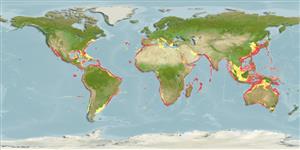Elasmobranchii (sharks and rays) >
Carcharhiniformes (Ground sharks) >
Carcharhinidae (Requiem sharks)
Etymology: Carcharhinus: karcharos (Gr.), sharp or jagged; rhinus, an ancient name for sharks, from rhine (Gr.), rasp, both words alluding to a shark's jagged, rasp-like skin. (See ETYFish); obscurus: Latin for dark, probably referring to its darkish blue-gray body color. (See ETYFish).
More on author: Lesueur.
Environment: milieu / climate zone / depth range / distribution range
Ecology
Marine; brackish; reef-associated; oceanodromous (Ref. 51243); depth range 0 - 400 m (Ref. 244), usually 200 - 400 m. Subtropical; 45°N - 46°S, 120°W - 156°E (Ref. 55186)
Western Atlantic: southern Massachusetts to Florida (USA), Georges Bank, Bahamas, Cuba, northern Gulf of Mexico, Nicaragua, southern Brazil and Uruguay (Ref. 58839). Eastern Atlantic: Canary Islands, Cape Verde, Senegal, Sierra Leone. Some records from the Mediterranean and Madeira may be based on Carcharhinus galapagensis. Indo-West Pacific: Red Sea (Ref. 5485), Mozambique and South Africa to Japan, China, Viet Nam and Australia. Eastern Pacific: southern California, USA to Gulf of California and the Revillagigedo Island. Highly migratory species.
Length at first maturity / Size / Weight / Age
Maturity: Lm 249.5, range 220 - 300 cm
Max length : 420 cm TL male/unsexed; (Ref. 5578); common length : 250 cm TL male/unsexed; (Ref. 26999); max. published weight: 346.5 kg (Ref. 4699); max. reported age: 40 years (Ref. 31395)
Dorsal
spines
(total): 0;
Dorsal
soft rays
(total): 0;
Anal
spines: 0;
Anal
soft rays: 0. A large shark with a broadly rounded snout, triangular saw-edged upper teeth, curved moderate-sized pectoral fins, and an interdorsal ridge (Ref. 5578). Blue-grey, lead-grey above, white below; tips of pectoral and pelvic fins, as well as lower lobe of caudal fin and dorsal fins often dusky in young, plain in adults (Ref. 9997).
Found in coastal and offshore waters but not oceanic (Ref. 5578). Adults are commonly found at depths of 200-400 m, young in shallower waters (Ref. 5485). A seasonal migratory species over parts of its range (Ref. 6871). Common component of the catch of the shark longline fishery (Ref.58048). Feeds on bottom and pelagic bony fish, sharks, skates, rays, cephalopods, gastropods, crustaceans, sometimes mammalian carrion and inorganic objects (Ref. 5578). Viviparous (Ref. 50449); with litter size number from 3-14 (Ref. 27549). Large adults are potentially dangerous (Ref. 4716, 6871). Utilized fresh, dried-salted, frozen and smoked for human consumption; hides for leather; fins for sharks-fin soup; and liver oil extracted for vitamins (Ref. 244).
Viviparous, with a yolk-sac placenta, litter size 3-14 pups (Ref. 244); 70-100 cm at birth (Ref. 6871). Gestation period of ~ 16 months (Ref.58048). Distinct pairing with embrace (Ref. 205).
Compagno, L.J.V., 1984. FAO Species Catalogue. Vol. 4. Sharks of the world. An annotated and illustrated catalogue of shark species known to date. Part 2 - Carcharhiniformes. FAO Fish. Synop. 125(4/2):251-655. Rome: FAO. (Ref. 244)
IUCN Red List Status (Ref. 130435)
Threat to humans
Traumatogenic (Ref. 4690)
Human uses
Fisheries: commercial; gamefish: yes
Tools
Special reports
Download XML
Internet sources
Estimates based on models
Preferred temperature (Ref.
123201): 8.7 - 18.6, mean 12.6 °C (based on 736 cells).
Phylogenetic diversity index (Ref.
82804): PD
50 = 0.5000 [Uniqueness, from 0.5 = low to 2.0 = high].
Bayesian length-weight: a=0.00759 (0.00428 - 0.01346), b=3.08 (2.93 - 3.23), in cm total length, based on LWR estimates for this species & Genus-body shape (Ref.
93245).
Trophic level (Ref.
69278): 4.3 ±0.2 se; based on diet studies.
Resilience (Ref.
120179): Very Low, minimum population doubling time more than 14 years (rm=0.02; also Musick et al. 2000 (Ref.
36717)).
Prior r = 0.09, 95% CL = 0.06 - 0.13, Based on 1 stock assessment.
Fishing Vulnerability (Ref.
59153): Very high vulnerability (88 of 100).
Climate Vulnerability (Ref.
125649): High vulnerability (62 of 100).
Nutrients (Ref.
124155): Calcium = 2.25 [0.42, 12.59] mg/100g; Iron = 0.295 [0.071, 0.898] mg/100g; Protein = 23 [20, 25] %; Omega3 = 0.163 [0.056, 0.425] g/100g; Selenium = 21.7 [6.3, 69.9] μg/100g; VitaminA = 24.1 [6.3, 93.0] μg/100g; Zinc = 0.398 [0.189, 0.797] mg/100g (wet weight);
